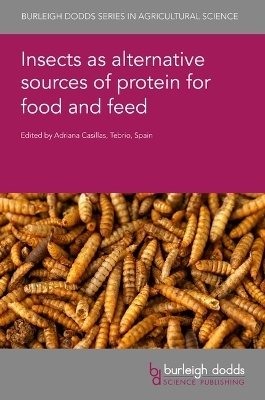
Insects as Alternative Sources of Protein for Food and Feed
Burleigh Dodds Science Publishing Limited (Verlag)
978-1-80146-584-7 (ISBN)
With significant concerns about the environmental impact of conventional crop and livestock production, there is a growing interest in utilising novel alternative sources of protein in both human and animal diets. Insects have long been consumed in the wild by an array of species, including poultry, fish and humans.
Insects as alternative sources of protein for food and feed provides a comprehensive overview of the recent research undertaken in this rapidly-expanding area. The book reviews the production and application of black soldier flies, yellow mealworms and other insects as alternative protein sources in poultry, pig and fish feed.
Through its considered approach, the book explores how the safety of extracted proteins can be ensured across the supply chain, as well as how we can better understand the changing attitudes of consumers towards eating protein derived from insects.
Edited by a leading expert in industry, the book will be a standard reference for university and other researchers in animal nutrition, companies involved in the manufacture of animal feed or animal nutrition services, government and other agencies regulating the animal feed sector, as well as farmers interested in utilising animal feed supplemented with insect-derived proteins.
Adriana Casillas is co-founder and CEO of Tebrio. Tebrio is Spain’s first, award-winning, large-scale manufacturer of insect protein for food, feed, pet food and other applications. Collaborators with Tebrio include the Universities of Almería, Burgos and Granada. Adriana was also Vice-President of the International Platform of Insects for Food and Feed (IPIFF) from 2016-2021 and is currently President of IPIFF.
Part 1 Production and applications of black soldier flies
1.Advances in substrate source composition for rearing black soldier fly larvae as a protein source: Cecilia Lalander and Ivã Guidini Lopes, Swedish University of Agricultural Sciences, Sweden;
2.Diseases affecting production of black soldier flies as a protein source: Roberto Pereira, University of Florida, USA;
3.Use of protein from black soldier flies in poultry feed: Teun Veldkamp, Wageningen University, The Netherlands;
4.Use of protein from black soldier flies in pig feed: Heidi Hall, Anpario, UK;
5.Use of protein from black soldier flies in fish feed: Laura Gasco, University of Turin, Italy;
Part 2 Production and application of yellow mealworms and other insects
6.Advances in mass breeding/rearing techniques for yellow mealworms as a protein source: David Deruytter, INAGRO, Belgium;
7.Advances in nutrient/substrate sources/composition for rearing yellow mealworms as a protein source: Riccardo Melis, Porto Conte Richerche, Italy;
8.Diseases affecting production of yellow mealworms as a protein source: Annette Brun Jensen, University of Copenhagen, Denmark;
9.Use of protein from yellow mealworms in poultry feed: Monnye Mabelebele, University of South Africa, South Africa;
10.Use of protein from yellow mealworms in fish feed: Enric Gisbert, IRTA, Spain;
11.Advances in production of house flies as food and animal feed: Vimal Selvaraj, Cornell University, USA;
12.Advances in production of crickets as food and animal feed: Chrysantus Tanga, icipe, Kenya;
Part 3 General issues in use of insect protein
13.Ensuring the safety of protein from insects: Christina Nielsen-Leroux, INRA, France;
14.Understanding and changing attitudes towards eating protein derived from insects: Ashkan Pakseresht, Brunel University, UK;
| Erscheinungsdatum | 12.11.2024 |
|---|---|
| Reihe/Serie | Burleigh Dodds Agricultural Science ; 154 |
| Co-Autor | Prof Nancy Carrejo, Dr Cecilia Lalander, Dr Roberto Pereira, Dr Teun Veldkamp |
| Verlagsort | Cambridge |
| Sprache | englisch |
| Themenwelt | Naturwissenschaften ► Chemie |
| Technik ► Lebensmitteltechnologie | |
| ISBN-10 | 1-80146-584-3 / 1801465843 |
| ISBN-13 | 978-1-80146-584-7 / 9781801465847 |
| Zustand | Neuware |
| Haben Sie eine Frage zum Produkt? |
aus dem Bereich


